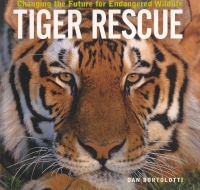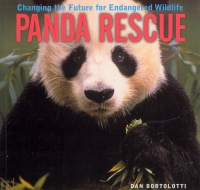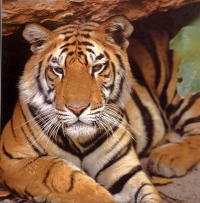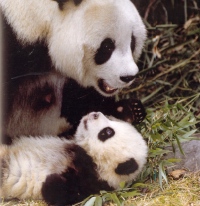| ________________
CM . . .
. Volume X Number 8. . . . December
12, 2003

 |
Tiger Rescue: Changing the Future for Endangered Wildlife. (Firefly Animal Rescue).
Dan Bortolotti.
Toronto, ON: Firefly Books, 2003.
64 pp., pbk. & cl., $9.95 (pbk.), $19.95 (cl.).
ISBN 1-55297-558-4 (pbk.), ISBN 1-55297-599-1 (cl.).
Subject Headings:
Tigers-Juvenile literature.
Endangered species-Juvenile literature.
Grades 8 and up / Ages 13 and up.
Review by Gillian Richardson.
*** /4
|
 |
Panda Rescue: Changing the Future for Endangered Wildlife. (Firefly Animal Rescue).
Dan Bortolotti.
Toronto, ON: Firefly Books, 2003.
64 pp., pbk. & cl., $9.95 (pbk.), $19.95 (cl.).
ISBN 1-55297-557-6 (pbk.), ISBN 1-55297-598-3 (cl.).
Subject Headings:
Pandas-Juvenile literature.
Endangered species-Juvenile literature.
Wildlife conservation-China-Juvenile literature.
Grades 8 and up / Ages 13 and up.
Review by Gillian Richardson.
*** /4
|

excerpt:
The Times of London has reported that the panda is "one of a group of survivors of the last ice age that has been slowly dying off as their habitats contract naturally." And the former editor of China's Great Nature magazine has written, "Just as all living creatures go through three different phases - birth, development and decline - so has the panda species. The giant panda has entered its decline."Even if we were to protect pandas and their habitat, the thinking goes, it wouldn't make a difference in the long run."
These arguments frustrate conservationists, who believe we must accept that the panda's main threat are saws and snares, not the animals' own nature. Only then will humans be able to come up with a realistic plan to save the species. (From Panda Rescue.)
The first two books in a new series, "Firefly Animal Rescue," feature the tiger and the giant panda, endangered mammals with no natural predators. The series is intended to raise awareness of the critical status of these animals due to shrinking habitat, poaching, and wildlife trade. As the subtitle, Changing the Future for Endangered Wildlife, suggests, each book details efforts to save the tiger and panda, gives background, profiles of scientists working on their behalf worldwide, and challenges readers to learn more and offer support through international conservation organizations.
 Each 64 page book begins with a general introduction and map showing locations of remaining animals. "The Story So Far" outlines the progress of conservation efforts since the species were first observed and studied: the 1960s for tigers, the 1940s for pandas. The following pages alternate natural history information with profiles ("On the Frontlines") of individuals involved in projects in China, India, Russia, Malaysia and Sumatra. A couple of chapters discuss ways captive animals contribute to data that may help their wild counterparts. "What is the Tiger/Panda's Future" summarizes the contents and offers a hopeful conclusion. "Fast Facts" gives a quick overview of the species. Final pages list conservation organizations and websites where additional information is available, and an Index. Colour photos throughout show the animals both in wild and captive situations, and depict researchers at work. Each 64 page book begins with a general introduction and map showing locations of remaining animals. "The Story So Far" outlines the progress of conservation efforts since the species were first observed and studied: the 1960s for tigers, the 1940s for pandas. The following pages alternate natural history information with profiles ("On the Frontlines") of individuals involved in projects in China, India, Russia, Malaysia and Sumatra. A couple of chapters discuss ways captive animals contribute to data that may help their wild counterparts. "What is the Tiger/Panda's Future" summarizes the contents and offers a hopeful conclusion. "Fast Facts" gives a quick overview of the species. Final pages list conservation organizations and websites where additional information is available, and an Index. Colour photos throughout show the animals both in wild and captive situations, and depict researchers at work.
 The author makes his case for the urgent need to join the conservation effort in an objective manner with up-to-date facts and a thorough examination of the threats and challenges each species faces. Why save tigers and pandas? Considerable focus is given to the cultural value of these animals and how it is possible for them to coexist with the people who share the same habitat. The tiger is a traditional symbol of power and strength, closely connected to rituals and folk medicine in the east but also an 'indicator species' in the food chain. The panda's appeal is worldwide, though it was virtually unknown in North America before the 1930s, and it "has only recently become a true Chinese emblem". However, it symbolizes conservation not only of a single species, (only 1000 animals are thought to exist in the wild) but also of the need for habitat restoration, unfolding through an ambitious plan by the Chinese government to restore areas of forest and find alternate sources of income for the people whose agricultural lifestyle is affected. The author makes his case for the urgent need to join the conservation effort in an objective manner with up-to-date facts and a thorough examination of the threats and challenges each species faces. Why save tigers and pandas? Considerable focus is given to the cultural value of these animals and how it is possible for them to coexist with the people who share the same habitat. The tiger is a traditional symbol of power and strength, closely connected to rituals and folk medicine in the east but also an 'indicator species' in the food chain. The panda's appeal is worldwide, though it was virtually unknown in North America before the 1930s, and it "has only recently become a true Chinese emblem". However, it symbolizes conservation not only of a single species, (only 1000 animals are thought to exist in the wild) but also of the need for habitat restoration, unfolding through an ambitious plan by the Chinese government to restore areas of forest and find alternate sources of income for the people whose agricultural lifestyle is affected.
The books in this series are promoted as being accessible and appealing to children aged 10 and up. The chapters are short (generally only a couple of pages), and the books are liberally illustrated. The reading level is quite sophisticated for the average elementary student, but, if used in conjunction with a unit on endangered animals, the books will promote discussion and debate, one of their objectives. The lengthy Table of Contents could benefit from some bold subheadings.
Recommended.
Gillian Richardson, who lives in BC, is a freelance writer and former teacher-librarian.

To comment
on this title or this review, send mail to cm@umanitoba.ca.
Copyright © the Manitoba Library Association. Reproduction for personal
use is permitted only if this copyright notice is maintained. Any
other reproduction is prohibited without permission.
NEXT REVIEW |TABLE OF CONTENTS FOR THIS ISSUE
- December 12, 2003.
AUTHORS
| TITLES | MEDIA REVIEWS
| PROFILES
| BACK ISSUES
| SEARCH | CMARCHIVE
| HOME |


 Each 64 page book begins with a general introduction and map showing locations of remaining animals. "The Story So Far" outlines the progress of conservation efforts since the species were first observed and studied: the 1960s for tigers, the 1940s for pandas. The following pages alternate natural history information with profiles ("On the Frontlines") of individuals involved in projects in China, India, Russia, Malaysia and Sumatra. A couple of chapters discuss ways captive animals contribute to data that may help their wild counterparts. "What is the Tiger/Panda's Future" summarizes the contents and offers a hopeful conclusion. "Fast Facts" gives a quick overview of the species. Final pages list conservation organizations and websites where additional information is available, and an Index. Colour photos throughout show the animals both in wild and captive situations, and depict researchers at work.
Each 64 page book begins with a general introduction and map showing locations of remaining animals. "The Story So Far" outlines the progress of conservation efforts since the species were first observed and studied: the 1960s for tigers, the 1940s for pandas. The following pages alternate natural history information with profiles ("On the Frontlines") of individuals involved in projects in China, India, Russia, Malaysia and Sumatra. A couple of chapters discuss ways captive animals contribute to data that may help their wild counterparts. "What is the Tiger/Panda's Future" summarizes the contents and offers a hopeful conclusion. "Fast Facts" gives a quick overview of the species. Final pages list conservation organizations and websites where additional information is available, and an Index. Colour photos throughout show the animals both in wild and captive situations, and depict researchers at work.  The author makes his case for the urgent need to join the conservation effort in an objective manner with up-to-date facts and a thorough examination of the threats and challenges each species faces. Why save tigers and pandas? Considerable focus is given to the cultural value of these animals and how it is possible for them to coexist with the people who share the same habitat. The tiger is a traditional symbol of power and strength, closely connected to rituals and folk medicine in the east but also an 'indicator species' in the food chain. The panda's appeal is worldwide, though it was virtually unknown in North America before the 1930s, and it "has only recently become a true Chinese emblem". However, it symbolizes conservation not only of a single species, (only 1000 animals are thought to exist in the wild) but also of the need for habitat restoration, unfolding through an ambitious plan by the Chinese government to restore areas of forest and find alternate sources of income for the people whose agricultural lifestyle is affected.
The author makes his case for the urgent need to join the conservation effort in an objective manner with up-to-date facts and a thorough examination of the threats and challenges each species faces. Why save tigers and pandas? Considerable focus is given to the cultural value of these animals and how it is possible for them to coexist with the people who share the same habitat. The tiger is a traditional symbol of power and strength, closely connected to rituals and folk medicine in the east but also an 'indicator species' in the food chain. The panda's appeal is worldwide, though it was virtually unknown in North America before the 1930s, and it "has only recently become a true Chinese emblem". However, it symbolizes conservation not only of a single species, (only 1000 animals are thought to exist in the wild) but also of the need for habitat restoration, unfolding through an ambitious plan by the Chinese government to restore areas of forest and find alternate sources of income for the people whose agricultural lifestyle is affected.